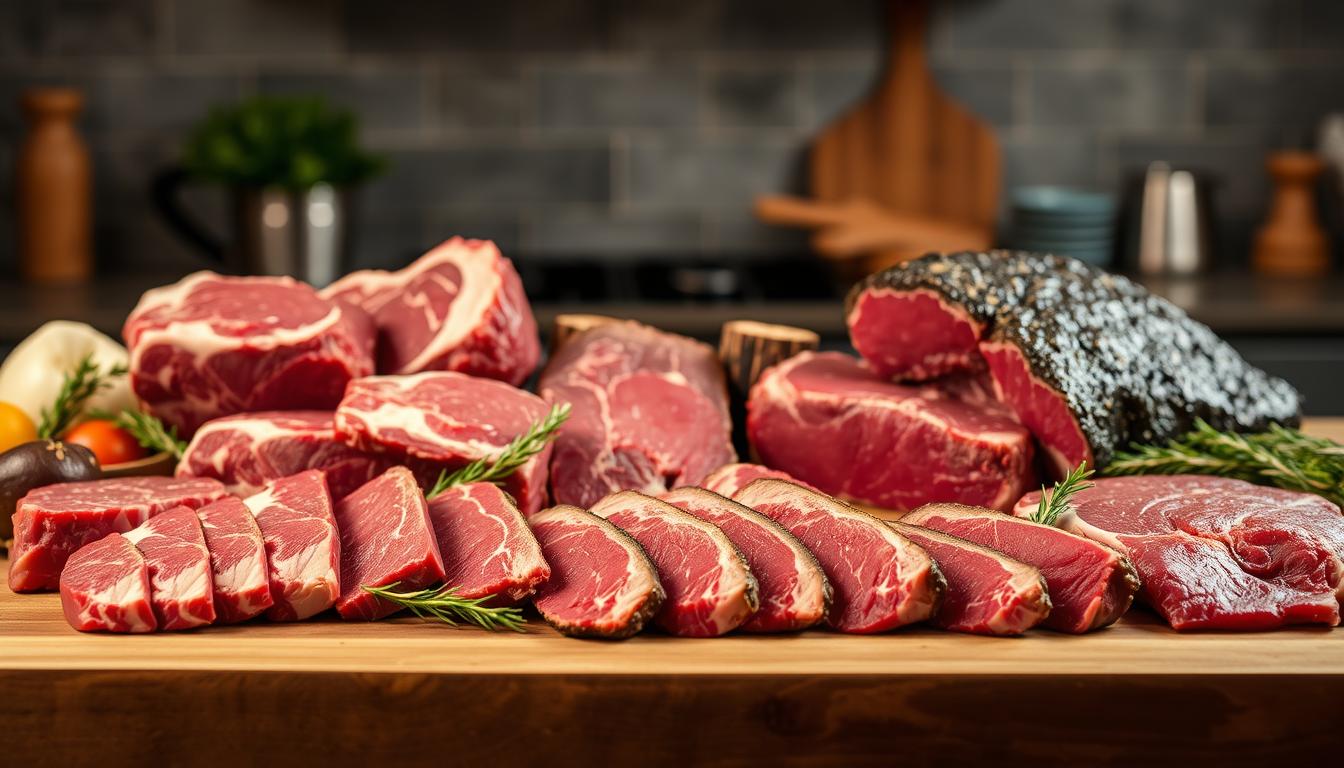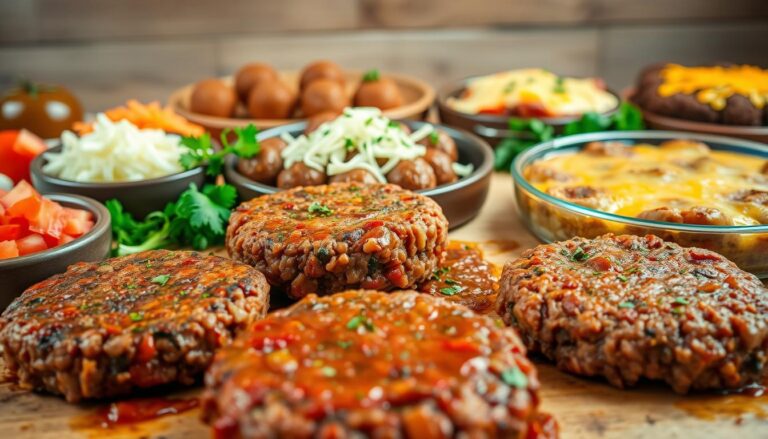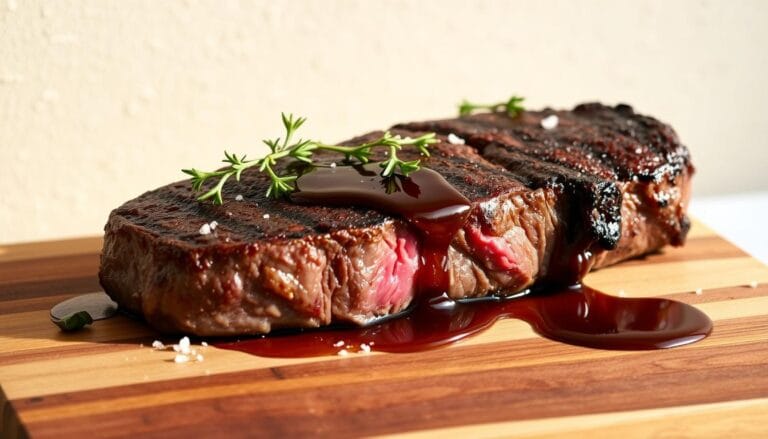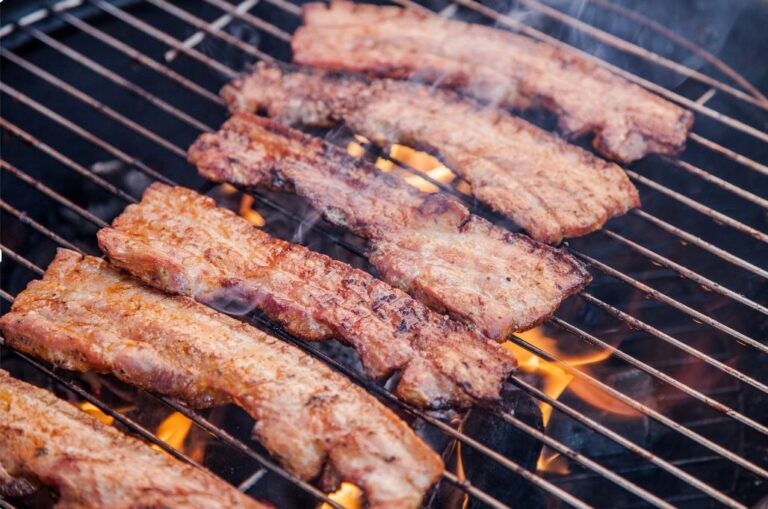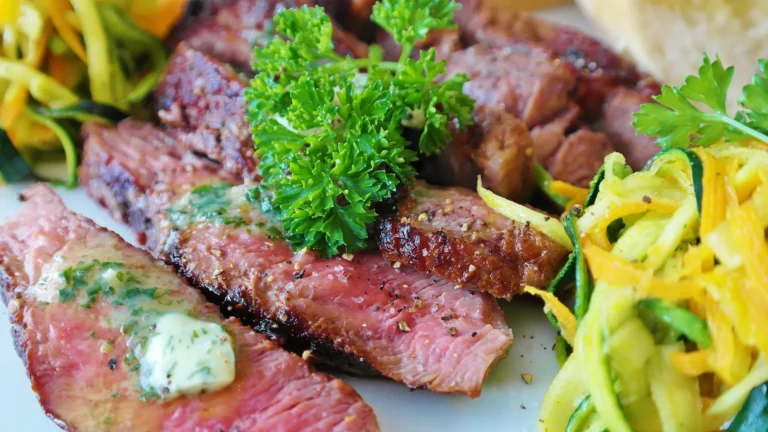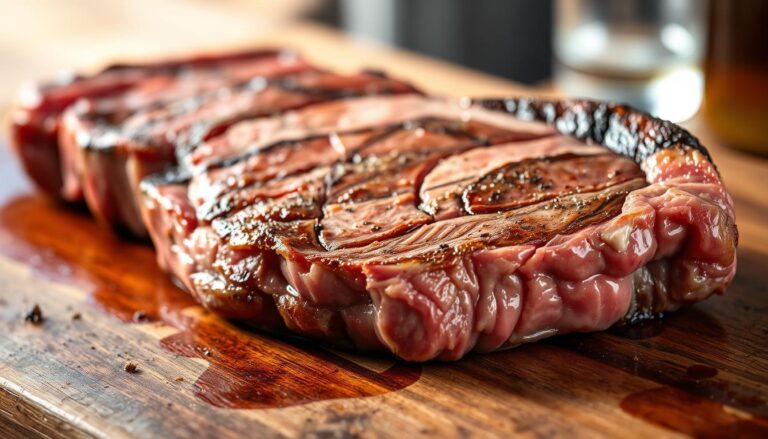Your Guide to Cooking Beef Medium Well Temp
Table of Contents
Your Guide to Cooking Beef Medium Well Temp
Cooking the perfect steak can be tough, aiming for the right balance of juiciness and safety. A medium well temperature is perfect, with a hint of pink in the center.
Maybe you’ve wondered about the exact temperature and cooking methods for this. Whether you’re an experienced cook or new to steak, knowing how to cook beef to the right doneness is essential.
Key Takeaways
- Understand the ideal internal temperature for cooking beef to medium well.
- Learn various cooking methods and techniques to achieve the perfect doneness.
- Discover expert tips for ensuring your steak remains juicy and flavorful.
- Explore common mistakes to avoid when cooking beef to medium well.
- Gain confidence in cooking steaks that impress, every time.
Understanding Beef Doneness Levels
Knowing the different levels of beef doneness is key to perfect cooking. The doneness level greatly impacts the meat’s texture, flavor, and quality.
What Are the Different Levels of Doneness?
Beef doneness has five main levels: rare, medium rare, medium, medium well, and well done. Each level has a specific internal temperature and look. For example, rare beef is between 120-125°F, with a cool red center.
As you move to well done, the temperature goes up, and the color changes too.
The internal temperatures for each level are as follows:
| Doneness Level | Internal Temperature (°F) | Description |
|---|---|---|
| Rare | 120-125 | Cool red center |
| Medium Rare | 130-135 | Warm red center |
| Medium | 140-145 | Warm pink center |
| Medium Well | 150-155 | Slightly pink center |
| Well Done | 160 and above | No pink remaining |
Cooking Temperatures for Each Doneness
Cooking beef to the right temperature is vital for the right doneness. The temperature changes the meat’s protein, fat, and moisture, affecting its flavor and texture. For instance, medium beef temp (140-145°F) gives a warm pink center.
How Doneness Affects Flavor and Texture
The doneness level greatly impacts beef’s flavor and texture. As beef cooks, proteins contract, and fat melts, making it tender and juicy. Overcooking makes the meat dry and tough, while undercooking makes it less tender.
“The art of cooking beef is not just about following a recipe; it’s about understanding the nuances of temperature and texture to achieve the perfect doneness.”
By understanding beef doneness and its temperatures, you can enjoy cooking to your liking, whether it’s medium well or another level.
What Is Medium Well Beef?
Knowing what medium well beef is key for perfect cooking. It’s a doneness level many enjoy. It’s cooked enough but not too dry, keeping it juicy.
For medium well beef, the internal temperature is key. The ideal beef medium well temp ranges from 150°F to 155°F (65°C to 68°C). This ensures the beef is mostly done but has a bit of pink inside. It’s cooked enough to be firm but not too dry.
The Ideal Temperature for Medium Well
Getting the right internal temperature is vital for medium well. The temperature should be between 150°F and 155°F. A meat thermometer is the best way to check this. Remember, the temperature might rise a bit after cooking.
Characteristics of Medium Well Beef
Medium well beef looks different from other doneness levels. It has a warm center with a hint of pink, surrounded by a brown crust. The outside is flavorful, and the inside is juicy but not bloody. This mix of texture and taste is what makes it special.
Why Choose Medium Well?
Many choose medium well for its balance. It’s juicier than well done but safer than medium. It’s great for those who want flavor and tenderness without the risk of undercooked meat.
| Doneness Level | Internal Temperature (°F) | Internal Temperature (°C) | Characteristics |
|---|---|---|---|
| Medium Well | 150-155 | 65-68 | Hint of pink in the center, firm texture, flavorful crust |
| Medium | 140-145 | 60-63 | Pink throughout, juicy, moderate texture |
| Well Done | 160+ | 71+ | No pink, fully cooked, dry texture |
Understanding medium well beef helps you cook better. Whether grilling, roasting, or pan-searing, getting it right makes your meal better.
Choosing the Right Cut of Beef
To cook beef to a perfect medium well, it’s key to know about different cuts. The cut you choose greatly affects your success in getting the perfect beef medium well temperature. Each cut has its own marbling, tenderness, and thickness, which all play a part in the final taste and texture.
Popular Cuts for Medium Well Cooking
Cuts like ribeye, New York strip, and sirloin work well for medium well. They stay moist even when cooked at higher temperatures. These are great for those wanting a beef well done temp without losing too much juiciness.
Leaner cuts, like filet mignon, can get dry at beef medium well temperature. Very fatty cuts, like brisket, need longer cooking to melt the fat right.
Factors to Consider When Selecting Beef
When picking beef, think about the grade (Prime, Choice, or Select), aging (wet or dry), thickness (1-1.5 inches for steaks), and marbling (intramuscular fat that adds flavor and juiciness). The grade shows the beef’s quality and tenderness, with Prime being the highest.
- Grade: Prime, Choice, or Select
- Aging: Wet or dry aging affects tenderness and flavor
- Thickness: Ideally 1-1.5 inches for steaks
- Marbling: Intramuscular fat that enhances flavor and juiciness
How Cut Affects Cooking Time
The thickness and density of the cut affect cooking time. Thicker steaks need longer to reach the right internal temperature. Denser muscle cuts like round or chuck take longer than tender cuts like tenderloin. Knowing these helps plan your cooking for consistent results at the perfect 150-155°F beef medium well temperature.
For instance, a thicker ribeye cooks longer than a thinner sirloin steak. Adjusting cooking time based on the cut ensures you get the desired doneness.
Essential Cooking Methods for Medium Well Beef
There are many ways to cook medium well beef, each with its own benefits. The best method depends on your tools, the beef cut, and what you like.
Grilling for Medium Well Perfection
Grilling is great for medium well beef. It gives a nice char on the outside and the right medium well temperature inside. Start by searing the beef over high heat (around 450-500°F) to get a good crust. Then, move it to a cooler part of the grill (around 350-375°F) to finish cooking it to your desired medium beef temp.
Searing and Roasting Techniques
Another good method is searing and then roasting. This involves searing the beef in a hot skillet to create a flavorful crust. Then, move it to the oven to roast until it reaches the right internal temperature. This method works well for thicker cuts, ensuring even cooking.
Culinary experts say, “Searing the beef before roasting not only enhances the flavor but also improves the texture by creating a tender crust.” This technique is a great way to get a perfect medium well finish.
Sous Vide for Controlled Cooking
Sous vide cooking is a precise way to get a perfect medium well temperature. By sealing the beef in a bag and cooking it in a water bath set at the exact desired temperature (typically 150°F for medium well), you can ensure even cooking. After sous vide cooking, a quick sear can add a satisfying crust to the beef.
- Sous vide ensures precise temperature control.
- Results in consistent doneness throughout the beef.
- A final sear adds texture and flavor.
Preparing Your Beef for Cooking
To cook beef to a perfect medium well temp, start with the right preparation. This ensures your beef cooks evenly and reaches the right medium well temperature.
Importance of Resting Meat Before Cooking
Letting your beef warm up to room temperature before cooking is key. It should sit on the counter for 30-60 minutes. This helps it cook more evenly, avoiding unevenness.
Seasoning Your Beef for Flavor Enhancement
Seasoning is vital for flavor. Start with kosher salt and black pepper 40 minutes before cooking. For more taste, add garlic powder, onion powder, or herbs like rosemary and thyme.
- Use kosher salt and freshly ground black pepper as a base.
- Add garlic powder or onion powder for an extra layer of flavor.
- Incorporate herbs like rosemary or thyme for a savory taste.
Using Marinades and Rubs
Marinades with acidic ingredients tenderize tougher cuts and add flavor. But, marinate for no more than 24 hours to avoid mushiness. Dry rubs create a tasty crust during cooking.
- Choose a marinade that complements the beef’s natural flavor.
- Apply dry rubs evenly to ensure consistent flavor.
- Be mindful of the marinating time to avoid over-tenderization.
By following these steps, you’ll cook beef to a perfect medium well temp. It will have great flavor and texture.
Tools and Equipment You Will Need
To get the perfect beef medium well, you need the right tools. The right equipment makes a big difference in your beef’s quality. It ensures it’s cooked just right.
Essential Cooking Tools for Beef Preparation
First, you need the right tools for your beef. A good cutting board, made of wood or plastic, is key. You’ll also need sharp knives, like a chef’s knife and a boning knife, to cut your beef well. Tongs are also a must, as they let you handle the meat without losing juices.
- A sturdy cutting board
- Sharp knives (chef’s knife and boning knife)
- Tongs for handling meat
Best Thermometers for Accurate Cooking
A reliable meat thermometer is key for precise beef medium temp. Instant-read digital thermometers, like the ThermoPop or Thermapen, give quick and accurate readings. Leave-in probe thermometers let you monitor the temperature without opening the oven or grill, ensuring your beef is cooked just right.
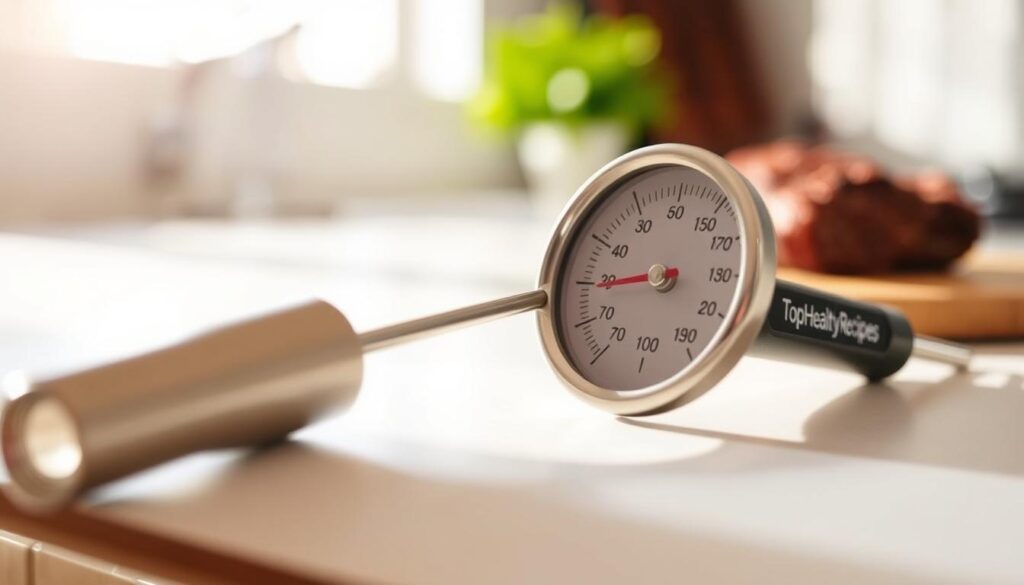
Equipment for Grilling or Roasting
For grilling, a good grill is essential, whether it’s gas or charcoal. Tools like grill brushes and a chimney starter can make grilling better. For roasting, a heavy-duty roasting pan, a rack, and a cast iron skillet for searing are important. Don’t forget heat-resistant gloves, a timer, and aluminum foil for tenting during rest periods.
- Well-maintained grill (gas or charcoal)
- Grill brushes and chimney starter
- Heavy-duty roasting pan and rack
- Cast iron skillet
Investing in these tools and equipment will help you cook perfect beef medium well temperature every time. Each tool is important for preparing, cooking, and serving your beef at its best.
The Cooking Process: Step-by-Step
To get the perfect medium well temp for beef, follow a few steps. First, prepare your grill or oven. Then, know how long to cook different cuts. Lastly, keep an eye on the beef’s temperature.
Preparing the Grill or Oven
Start by cleaning the grates if you’re grilling. Set up two heat zones: one hot for searing and another medium for finishing. This method helps create a nice crust and cooks the beef just right. If you’re using the oven, preheat to 350°F and ready a cast iron skillet for searing.
Preheating is key to ensure the cooking surface is ready when you start.
Cooking Times for Different Cuts
Cooking times change based on the cut and its thickness. For example, a 1-inch ribeye takes 4-5 minutes per side on the grill, plus resting time. A 3-pound roast might need 25-30 minutes per pound. Remember, these are just guidelines, and actual times can vary.
| Cut of Beef | Thickness | Grilling Time per Side | Oven Cooking Time per Pound |
|---|---|---|---|
| Ribeye | 1 inch | 4-5 minutes | N/A |
| Roast | 3 pounds | N/A | 25-30 minutes |
| Sirloin | 1.5 inches | 5-6 minutes | N/A |
Monitoring Beef Temperature Accurately
It’s better to check the beef’s internal temperature than just cooking time. Use a thermometer in the thickest part of the meat, avoiding fat or bone. For medium well, take the beef out when it hits 145-150°F. It will warm up a bit more during resting.
Using a leave-in probe thermometer makes it easier. You can set it to alert you at 145°F. Thinner cuts cook quicker and have less carryover, so you might remove them closer to 150-155°F.
Resting Your Beef After Cooking
Resting your beef after cooking is key to keeping it juicy. When you cook, the meat’s fibers contract, pushing moisture to the center. Resting lets these fibers relax and soak up some of that moisture again.
This makes your beef juicier and keeps more flavorful juices inside. Also, resting allows the meat to cook a bit more, raising its internal temperature by about 5°F. So, take the beef off the heat before it hits the medium beef temp.
The Science Behind Resting
Resting is simple science. Cooking beef tightens the proteins, pushing juices to the surface. Letting it rest relaxes these proteins, spreading the juices evenly through the meat.
How Long to Let Your Beef Rest
Steaks should rest for 5-10 minutes if cooked to medium well. Bigger roasts need 15-30 minutes, depending on their size.
Best Practices for Resting
To rest your beef right, cover it loosely with foil to keep heat in. Don’t trap steam that could make the crust soft. Place the meat on a wire rack over a plate or cutting board to catch juices.
These juices are great with the meat or in a sauce. Don’t cut into the meat until it’s fully rested. Cutting too soon lets juices escape instead of spreading through the beef.
By following these tips, your beef will stay juicy and full of flavor. This makes your effort to get the perfect medium beef temp worth it.
Delicious Side Dishes to Pair with Medium Well Beef
The perfect medium well beef needs great side dishes to make a complete meal. When cooking beef to the ideal beef medium well temperature, pick sides that match its rich taste.
Vegetable Sides to Complement Your Meal
Vegetable sides offer a fresh contrast to the beef’s richness. Try roasting asparagus, Brussels sprouts, or mushrooms to enhance their taste. Grilled veggies like zucchini, bell peppers, and onions are also great, perfect for those grilling their beef. For a lighter choice, a crisp salad with tangy dressing is refreshing.
- Roasted asparagus
- Grilled zucchini
- Brussels sprouts with balsamic glaze
Starches That Match Well with Beef
Starchy sides are a classic match for beef, adding to the meal’s satisfaction. Baked potatoes, mashed potatoes, or potato gratin are favorites that go well with medium well beef. Rice pilaf, creamy polenta, or crusty bread also soak up the beef’s juices.
- Baked potatoes with herbs
- Creamy polenta
- Crusty bread with butter
Wine and Beverage Pairing Suggestions
There are many drinks to pair with medium well beef. For wine lovers, medium to full-bodied reds like Cabernet Sauvignon, Merlot, or Syrah are good choices. Full-bodied Chardonnay works well for white wine fans. Non-alcoholic options include unsweetened iced tea, sparkling water with lemon, or strong coffee.
Choosing the right side dishes and drinks makes a meal complete. It highlights your perfectly cooked medium well beef.
Common Mistakes to Avoid
Cooking beef to medium well temp needs focus to avoid common mistakes. Even skilled cooks can make errors that affect the taste and texture of the meat.
Overcooking Your Beef
One big mistake is overcooking beef past the medium well range of 150-155°F. Beef cooked beyond this point becomes dry and less tasty. To avoid this, take the beef off the heat 5-10°F before your target temperature to account for carryover cooking.
Not Using a Meat Thermometer
Not using a meat thermometer is another big error. Relying on looks or the “touch test” is not reliable. A good digital thermometer is key for consistent results.
Ignoring Rest Time Post-Cooking
Ignoring rest time is a common mistake. Cutting into beef right after cooking lets juices spill out. Always let steaks rest 5-10 minutes and bigger cuts 15-30 minutes before serving.
Other mistakes to avoid include:
- Cooking cold beef straight from the fridge, leading to uneven cooking.
- Frequent flipping or moving the meat, which stops proper searing.
- Seasoning too late, as salt needs time to soak into the meat.
| Common Mistakes | Consequences | Solutions |
|---|---|---|
| Overcooking | Dry, less flavorful meat | Remove from heat 5-10°F before target temp |
| Not using a thermometer | Inconsistent doneness | Invest in a digital thermometer |
| Ignoring rest time | Loss of juices | Rest steaks for 5-10 minutes, larger cuts for 15-30 minutes |
Knowing these common mistakes and how to avoid them can greatly improve your cooking. This way, you can achieve perfect medium well beef more often.
“The difference between a good cook and a great cook is attention to detail and a willingness to learn from mistakes.”
Storing Leftover Medium Well Beef
Proper storage and reheating are key to enjoying leftover medium well beef. It’s important to keep the beef safe to eat and flavorful. You need to pay attention to how you store and reheat it.
Proper Storage Techniques
Cool leftover medium well beef to room temperature within two hours to stop bacteria from growing. Once it’s cooled, wrap it tightly in plastic wrap or foil. Then, put it in an airtight container. This keeps the beef moist and prevents contamination.
Refrigeration: Cooked beef can stay in the fridge for 3-4 days. Make sure your fridge is at 40°F (4°C) or colder.
Freezing: For longer storage, freeze the beef. Wrap it in airtight containers or freezer bags. Remove air to prevent freezer burn. Frozen beef can last 2-3 months.
How to Reheat Without Drying Out
Reheating beef to beef medium well temp needs care to avoid overcooking to beef well done temp. You want to warm it up without cooking it more.
For steaks, wrap them in foil and heat in a 250°F oven until they reach 110-120°F. This takes about 15-20 minutes. Then, briefly sear the steak in a hot pan to restore its crust.
For roasts, slice the beef thinly and reheat it gently in beef broth or gravy over low heat. Make sure it doesn’t simmer or boil.
Creative Ways to Use Leftover Beef
Leftover medium well beef is great for many dishes, making it a versatile ingredient for future meals.
| Dish | Description | Preparation Tip |
|---|---|---|
| Beef Sandwiches | Thinly slice the leftover beef for sandwiches or wraps. | Add your favorite condiments and vegetables. |
| Beef Stroganoff | Dice the beef and sauté it with mushrooms and your choice of stroganoff sauce. | Serve over egg noodles. |
| Stir-Fries | Slice the beef into thin strips and stir-fry with your favorite vegetables. | Add soy sauce or stir-fry sauce to taste. |
Tips for Perfecting Your Medium Well Cooking Skills
Getting the perfect medium well beef temperature takes practice and a bit of experimentation. It’s important to know how different factors affect your cooking, like the beef cut and cooking method.
Practice Makes Perfect: Cooking Frequency
Being consistent is key to improving your cooking. Try setting aside a day each week for cooking beef, like a “steak night.” Keeping a log of your cooking experiments helps you track your progress. This log will help you repeat your successes and learn from your failures.
Experimenting with Different Cuts and Methods
Beef cuts vary in fat and muscle, affecting how they cook. Try different cuts like ribeye, strip steak, sirloin, and filet to see how they cook at medium well temperature. Also, try different cooking methods like grilling, pan-searing, roasting, or sous vide to see how they change the beef’s texture and taste.
| Cooking Method | Best for | Tips |
|---|---|---|
| Grilling | Thicker cuts | Preheat grill to high heat; sear for 3-4 minutes per side. |
| Pan-Searing | Thinner cuts | Use a hot skillet with oil; sear for 2-3 minutes per side. |
| Sous Vide | Consistency | Cook sealed meat in water bath at 130°F – 135°F for medium well. |
Tasting and Adjusting Your Techniques
It’s important to taste your beef to improve your cooking. Notice the texture, juiciness, flavor, and doneness. If your beef is too done, cook it at a slightly lower temperature. Changing your seasoning or searing technique can also improve your dish’s taste and look.
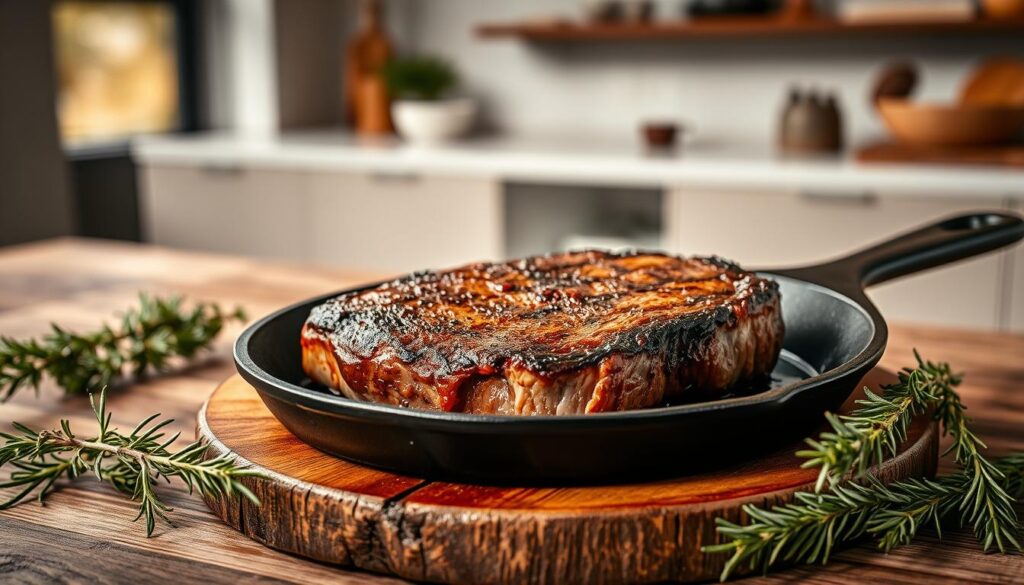
By cooking regularly, trying different cuts and methods, and tasting carefully, you’ll get better at cooking medium well beef every time.
FAQs About Cooking Medium Well Beef
Learning to cook medium well beef takes practice and the right tips. You’ll face common questions and challenges. This section answers those FAQs and offers troubleshooting tips to help you succeed.
Common Questions and Answers
Cooking beef to the right temperature is key. Here are some common questions and their answers to guide you.
- What is the medium beef temp range? Medium beef is cooked to 140-145°F, with a warm pink center. Medium well temp is 150-155°F, with just a hint of pink.
- How can I tell if my beef is medium well without a thermometer? Without a thermometer, medium well beef feels firm with a slight give. The juices run mostly clear with minimal pinkness.
- Why does my beef end up well-done when I’m aiming for medium well? This often happens due to not accounting for carryover cooking. Remove beef from heat at 145-150°F to allow it to rise to the final medium well temperature during resting.
Troubleshooting Cooking Issues
Even with the right information, issues can arise. Here are some troubleshooting tips to help you overcome common problems.
- Why is my beef tough? Toughness can result from the cut (choose more tender cuts for quick cooking), not resting the meat adequately, or slicing against the grain.
- How do I achieve a good crust while maintaining a medium well inside? Use the two-zone cooking method—high heat for searing the exterior, then lower heat to bring the center to temperature without burning the outside.
Expert Tips for Success
To consistently cook great medium well beef, consider these expert tips.
“The key to a perfect medium well beef is not just about the temperature, but also about the technique and the quality of the meat you choose.”
- Is medium well beef safe for everyone? Yes, beef cooked to 150-155°F is considered safe for all populations, including pregnant women and those with compromised immune systems.
- How can I ensure my beef stays juicy? Ensure you don’t overcook it, and always let it rest before slicing.
Conclusion: Perfecting Your Medium Well Beef
Remember, the perfect beef medium well temp is between 150-155°F. This temperature is safe, juicy, and flavorful. It also has just a hint of pink in the center.
Key Takeaways
Getting beef to medium well temperature is about more than just following a recipe. It’s about choosing the right cuts and letting them come to room temperature. You also need to pick the right cooking method for your cut.
Using a reliable thermometer to check the internal temperature is key. Don’t forget to let the meat rest for a while after cooking.
Continuing Your Culinary Journey
Cooking is a mix of science and art. Temperature guidelines help you cook with precision. But, it’s your personal touch and techniques that make your dishes special.
With practice and patience, you’ll get better at cooking beef to the perfect medium well. Try new cuts, improve your techniques, and find new flavors to enjoy.
Final Tips
Cooking beef to perfection shows off your culinary skills. Follow the tips and guidelines in this guide. You’ll soon master the art of cooking beef to a perfect medium well temperature.
FAQ
What exactly is the medium beef temp range?
How can I tell if my beef is medium well without a thermometer?
Why does my beef end up well-done when I’m aiming for medium well?
Why is my beef tough even though I cooked it to the right temperature?
How do I get a good crust while maintaining medium well inside?
Is medium well beef safe for everyone to eat?
What is the ideal temperature for cooking beef to medium well?
What are the best cuts of beef for medium well cooking?
How long should I let my beef rest after cooking?
For more cooking tips, stay connected with us. We also recommend the cookbook Skinnytaste Simple: Easy, Healthy Recipes with 7 Ingredients or Fewer
For more Recipes about Steak ?
Did You try our recipe ?
There are no reviews yet. Be the first one to write one.
